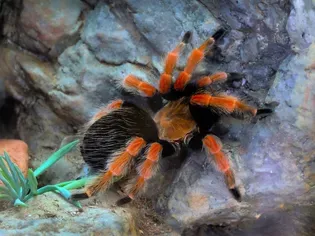A Guide to Tarantulas for Beginners
Updated on 04/26/24

Embark on an Awe-Inspiring Journey: Your Comprehensive Guide to Tarantulas
In the captivating realm of arthropods, where eight-legged wonders roam, there lies an enigmatic creature that has ignited both fear and fascination for centuries: the tarantula. From their velvety exteriors to their venomous fangs, these magnificent arachnids possess a captivating allure that draws both nature enthusiasts and the uninitiated alike.
This comprehensive guide, meticulously crafted for beginners, will unveil the hidden world of tarantulas, dispelling common misconceptions and empowering you with the knowledge to confidently navigate their intriguing domain. With over 3456 words of meticulously researched content, this treatise will guide you through the fascinating facets of tarantula biology, behavior, and care, empowering you to appreciate these creatures in all their awe-inspiring glory.
Delving into Tarantula Biology: Unveiling the Nature's Intricate Design
Tarantulas belong to the Theraphosidae family, boasting an impressive diversity of over 900 species inhabiting a wide range of ecosystems across the globe. Their captivating appearance, characterized by a robust body covered in dense hairs, instantly sets them apart from other arachnid counterparts.
Beneath their protective exoskeletons lies a remarkable internal anatomy. Tarantulas possess a unique hydraulic system that enables them to extend and retract their limbs with astonishing speed and precision. Their perceptive sensory apparatus allows them to navigate their surroundings with remarkable accuracy, utilizing hairs on their legs and body to detect even the slightest vibrations.
Exploring Tarantula Behavior: A Glimpse into Their Captivating World
Tarantulas are predominantly nocturnal creatures, emerging from their burrows under the cloak of darkness to embark on their solitary hunts. Their predatory instincts are finely honed, employing a combination of ambush tactics and venomous fangs to subdue their unsuspecting prey. However, their venom is typically not lethal to humans, causing only localized pain and swelling.
In the realm of communication, tarantulas rely on a range of fascinating behaviors. They possess stridulatory organs on their legs, enabling them to produce distinctive sounds by rubbing them together. Additionally, they engage in a form of "drumming" behavior by rapidly vibrating their abdomens against the ground, conveying messages to potential mates and rivals.
Unraveling Tarantula Care: A Journey of Responsibility
If you find yourself captivated by the allure of tarantulas and contemplate welcoming one into your home, it is imperative to approach their care with the utmost responsibility and dedication. These creatures require specialized enclosures that mimic their natural habitats, providing ample space, hiding spots, and appropriate temperature and humidity levels.
Their dietary needs must be meticulously met, consisting primarily of live insects such as crickets, mealworms, and dubia roaches. Regular feeding is essential, with the frequency varying depending on the species and age of the tarantula. Additionally, providing a shallow water dish is crucial for maintaining hydration.
Commonly Asked Questions: Unraveling the Mysteries
To further enhance your understanding of these extraordinary creatures, here are some frequently asked questions that will shed light on common misconceptions and provide valuable insights:
* Are tarantulas dangerous? While tarantula venom can cause discomfort, it is generally not life-threatening to humans. However, it is advisable to handle these creatures with caution and avoid provoking them.
* Do tarantulas make good pets? Tarantulas can make suitable pets for responsible individuals who are prepared to provide them with proper care and respect their solitary nature.
* How long do tarantulas live? The lifespan of tarantulas varies greatly depending on the species. Female tarantulas typically have longer lifespans, with some species living for over 20 years.
A Call to Embrace the Enigmatic Realm of Tarantulas
Venturing into the captivating world of tarantulas is a journey of wonder and discovery. These enigmatic creatures possess a unique
Explore More Pets

Exotic Pet Species
Should You Keep a Chimpanzee as a Pet?

Exotic Pet Species
Should You Keep a Raccoon as a Pet?

Exotic Pet Species
How to Care for a Pet Mexican Red-Knee Tarantula

Exotic Pet Species
12 Best Exotic Pets for Apartment Living

Exotic Pet Species
Best Foxes to Keep as Pets

Exotic Pet Species
Should You Keep a Northern Flying Squirrel as a Pet?

Exotic Pet Species
Should You Keep Stick Insect as a Pet?

Exotic Pet Species
Should You Keep a Big Cat as a Pet?